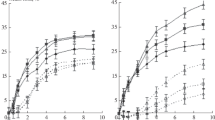Abstract
Composites of low-density polyethylene (LDPE), poly(ethylene-co-vinyl acetate) (EVA), poly(ethylene-co-octadecene), and an LDPE/EVA blend were prepared with different amounts of meloxicam (1, 3 and 5 wt %) by the melt blending process. Meloxicam was homogenously dispersed in polymer matrices. The polymer–meloxicam composites showed thermal behavior and thermal characteristics similar to those of the original polymers. Meloxicam release from the composites was examined in vitro for 50 days. The composites were incubated in phosphate-buffered solution and meloxicam concentration was determined by high-performance liquid chromatography. The prolonged release of the drug indicates that meloxicam-loaded plastic rings offer potential for control of reproduction and chronic inflammatory conditions.




Similar content being viewed by others
References
Google.com, Polymer applications. “The world of plastics and polymers”
Peppas N, Langer R (1994) New challenges in materials. Science, vol 263, March 1994 Surfaces B: Biointerfaces 116:169–175
Yapar EA, Inal O, Trop J (2012) Poly(ethylene oxide)-Poly(propylene oxide)-based copolymers for transdermal drug delivery: an Overview. Trop J Pharm Res 11:855–866
Chen G (2012) Nanotube based controlled drug delivery. Pharmaceut Anal Acta 3: e 136. doi:10.4172/2153-2435.1000e136
Huangl Ch L, Steelel TWJ, Widjaja E, Boeyl FYC, VenKatramal SS, Loo JSC (2013) NPG Asia Materialsa 5:e54. doi:10.01038/am2013:26
Richards JS (2001) Perspective: the ovarian follicle. A perspective in 201. Endocrinology 142:2184–2193
Bata MS, Al-Ramahi, Salhab AS, Gharaibeh MN, Schwartz J (2006) Delay of ovulation by meloxicam in healthy cycling volunteers; a placebo controlled, double blind, crossover study. J Clin Pharmacol 46:925–932
Jessam C, Salvatierra AM, Schwartz J, Croxatto HB (2009) Suppression of follicular rupture with meloxicam, a cyclooxygenase-2 inhibitor: potential for emergency contraception. Hum Reprod 25:368–373
Hardman JG, Limbird LE (eds) (1996) Goodmans and Gilman’s the pharmacological basis of therapeutics, 9th edn. McGraw-Hill, New York
Rabagliati FM, Pérez MA, Cancino RA, Soto MA, Rodríguez FJ, León AG, Ayal HA, Quijada R (2000) Homo- and copolymerization of styrene using Ph2Zn-metallocene-MAO systems. Bol Soc Chil Quím 45:219–226
Rabagliati FM, Rodríguez FJ, Alla A, Muñoz-Guerra S (2006) Styrene/(substituted styrene) copolymerization using Ph2Zn-metallocene-MAO sys-tems. Polym Int 55:910–915
Rabagliati FM, Muñoz LA, Quijada R (2011) Styrene copolymerization using metallocenic initiator: Homo- and copolymeryzation of styrene with isoprene through zirconocene-MAO initiator systems. Polym Bull 67:1425–1434
Rabagliati FM, Cancino RA, Rodriguez FJ (2001) Copolymerization of styrene by diphenylzinc-additive systems. Part II. Copolymerization of styrene/1-alkene by Ph2Zn-metallocene-MAO systems. Polym Bul 46:427–434
Rabagliati FM, Cancino RA, Martinez de Ilarduya A, Muñoz-Guerra S (2005) Homo- and copolymerization of styrene and 1-alkene using Ph2Zn- Et(Ind)2ZrCl2-MAO initiator systems. Eur PolymJ 42:1013–1019
Zapata PA, Tamayo L, Pàez M, Cerda E, Azocar I, Rabagliati FM (2011) Nanocomposites based on polyethylene and nanosilver particles pro-duced by metallocenic in situ polymerization :Synthesis, characteryzation, and antimicrobial behaviour. Eur Polym J 47:1541–1549
Tamayo LA, Zapata PA, Vejar ND, Azocar MI, Gulpi MA, Zhou X, Thompson GE, Rabagliati FM, Paez MA (2014) Release of silver and copper nanoparticles from polyethylene nanocomposites and their penetration into Listeria Manocyetogenes. Mater Sci Eng C, Accepted
Zapata PA, Palza H, Delgado K, Rabagliati FM (2012) Novel Antimi-crobial polyethylene nanocomposites prepared by metallocenic “in situ” polymerization with TiO2 based nanocomposites. J Polym Si. Part A. Polym Chem 50:4055–4062
Zapata PA, Palza H, Cruz LS, Lieberwirth I, Catalina F, Corrales T, Rabagliati FM (2013) Polyethylene and poly (ethylene-co-1-octadecene) composites with TiO2 based nanoparticles by metallocenic “in situ” polymerization. Polymer 54:2690–2698
Wei L, Tang T, Huang B (2004) Synthesis and characterization of polyethylene/clay–silica nanocomposites: a montmorillonite/silica-hybrid- supported catalyst and in situ polymerization. J Polym Sci Part A.: Polym Chem 42:941–949
Uyar T, Tonelli A, Hacaloglu (2006) Thermal degradation of polycarbonate, poly(vinyl acetate) and their blends. Polym Degrad Stability 91:2060–2067
Acknowledgments
Financial support from Departamento de Investigaciones Científicas y Tecnológicas, Universidad de Santiago de Chile, DICYT-USACH, under Project 021341 RC is gratefully acknowledged.
Author information
Authors and Affiliations
Corresponding author
Rights and permissions
About this article
Cite this article
Rabagliati, F.M., Zapata, P.A., Orihuela, G.P. et al. Preparation and characterization of a new polymer/pharmaceutical-based composite. Part I: Meloxicam. Polym. Bull. 71, 3323–3331 (2014). https://doi.org/10.1007/s00289-014-1252-9
Received:
Revised:
Accepted:
Published:
Issue Date:
DOI: https://doi.org/10.1007/s00289-014-1252-9




